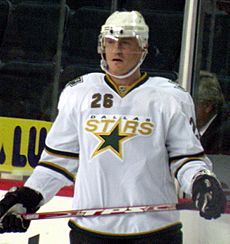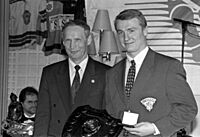Jere Lehtinen facts for kids
Quick facts for kids Jere Lehtinen |
||||||||||||||||||||||||||||||||||||||||||||||
|---|---|---|---|---|---|---|---|---|---|---|---|---|---|---|---|---|---|---|---|---|---|---|---|---|---|---|---|---|---|---|---|---|---|---|---|---|---|---|---|---|---|---|---|---|---|---|

Lehtinen with the Dallas Stars in March 2009
|
||||||||||||||||||||||||||||||||||||||||||||||
| Born | June 24, 1973 Espoo, Finland |
|||||||||||||||||||||||||||||||||||||||||||||
| Height | 6 ft 0 in (183 cm) | |||||||||||||||||||||||||||||||||||||||||||||
| Weight | 192 lb (87 kg; 13 st 10 lb) | |||||||||||||||||||||||||||||||||||||||||||||
| Position | Right wing | |||||||||||||||||||||||||||||||||||||||||||||
| Shot | Right | |||||||||||||||||||||||||||||||||||||||||||||
| Played for | Kiekko-Espoo TPS Dallas Stars |
|||||||||||||||||||||||||||||||||||||||||||||
| National team | ||||||||||||||||||||||||||||||||||||||||||||||
| NHL Draft | 88th overall, 1992 Minnesota North Stars |
|||||||||||||||||||||||||||||||||||||||||||||
| Playing career | 1990–2010 | |||||||||||||||||||||||||||||||||||||||||||||
|
Medal record
|
||||||||||||||||||||||||||||||||||||||||||||||
Jere Kalervo Lehtinen (born June 24, 1973) is a Finnish former professional ice hockey player. He was a right winger known for his excellent defensive skills. Jere was picked by the Minnesota North Stars in the 1992 NHL Draft. He played his entire 15-year National Hockey League (NHL) career with the same team, even after it moved to Dallas in 1993 and became the Dallas Stars.
Lehtinen was a "two-way forward," meaning he was great at both offense and defense. He is especially famous for his defensive play. He won the Frank J. Selke Trophy three times, which is given to the NHL's best defensive forward. After he stopped playing, he became the general manager for the Finnish national ice hockey team. In 2018, he was added to the IIHF Hall of Fame, a special honor for hockey legends.
Contents
Playing Career Highlights
Starting in Finland
Jere Lehtinen started his hockey journey playing in the 1987 Quebec International Pee-Wee Hockey Tournament with a youth team from his hometown, Espoo.
He began his professional career with his hometown team, Kiekko-Espoo. In 1991, his team won their division and earned a spot in Finland's top league, the SM-liiga. Lehtinen spent another year with Kiekko-Espoo.
After that, he joined one of Finland's biggest clubs, TPS in Turku, in 1993. There, he quickly became a strong offensive player. He often played alongside Saku Koivu, another future NHL star. Together, they helped TPS have a great season, though they lost in the finals.
The next season, 1994-1995, TPS and Lehtinen went all the way and won the SM-liiga championship! After this victory, Lehtinen was invited to play for the Finnish national team at the 1995 World Championships. Finland won their first-ever IIHF World Championship gold medal by beating Sweden 4–1 in the final. Lehtinen was part of a famous line with Saku Koivu and Ville Peltonen. Finnish fans called them "The boys of Duckburg" because of their nicknames, "Huey, Dewey, Louie." This line was also chosen as the tournament's all-star line.
Joining the Dallas Stars
Early Years (1995–2003)
After his amazing year in 1995, Jere Lehtinen moved to North America to play in the NHL. He quickly joined the Dallas Stars team. Within three years, he became a key player, often playing on the top line with star player Mike Modano.
In the 1996–97 season, he was nominated for the Frank J. Selke Trophy for the first time. This award goes to the best defensive forward in the NHL. In the 1997–98 season, he was chosen for the NHL All-Star Game. That same year, he won his first Selke Trophy, becoming the first Finnish player to do so. Lehtinen also won a bronze medal with the Finnish team at the 1998 Winter Olympics in Nagano, Japan.
In 1999, the Dallas Stars made it to the Stanley Cup Finals. They defeated the Buffalo Sabres in six games to win the Stanley Cup, hockey's biggest prize! In the final game, Lehtinen scored the first goal and then helped set up Brett Hull's winning goal in overtime. That year, Lehtinen had his best statistics and won the Selke Trophy again. He was only the third player in NHL history to win the award two years in a row.
The 1999–2000 season was tough for Lehtinen because of ankle problems. He missed many games due to injuries. However, he returned to help the Stars in the playoffs. They reached the Finals again but lost to the New Jersey Devils.
Lehtinen returned to his top form in the 2000–01 season, playing very well. The Stars made the playoffs but were knocked out in the second round.
In 2001–02, Lehtinen had another great season. He scored 25 goals and 24 assists. He also had the best plus-minus rating on his team, showing how good he was at both ends of the ice. He was chosen for the NHL All-Star Game again but could not play due to an injury.
He continued his strong play in 2002–03. He led the Stars with 31 goals, which was a new career high for him. He also had a fantastic plus-minus rating of +39. Lehtinen scored his second career hat-trick (three goals in one game) against the Los Angeles Kings. This year, he won the Selke Trophy for the third time! He joined a very small group of players who had won the award three or more times.
Later Years (2003–2010)
The 2003–04 season was a bit disappointing for Lehtinen because of knee injuries. He played in fewer games and had fewer points. The Stars lost in the first round of the playoffs.
Before the NHL lockout (when the league stopped playing for a season), the World Cup of Hockey took place. Lehtinen played for Finland again. Finland reached the final but lost to Canada.
Lehtinen had knee surgery during the lockout. After recovering, he played very well in the 2005–06 season. He tied his career high in points (52) and set a new career high in goals (33). The Stars won their division title. However, they were again eliminated in the first round of the playoffs. Lehtinen was nominated for the Selke Trophy again, finishing third in the voting.
The 2006 Winter Olympics in Turin happened during the 2005–06 NHL season. Lehtinen was a key player for Team Finland. He played on a line with Saku Koivu and Teemu Selänne. Finland reached the gold medal game but lost a close game to Sweden. If Finland had won, Lehtinen would have been the first Finn to join the Triple Gold Club (winning an Olympic gold, World Championship gold, and Stanley Cup).
In the 2006–07 season, Lehtinen scored 26 goals, leading his team for the second year in a row. The Stars, however, lost in the first round of the playoffs for the third straight season.
Lehtinen started the 2007–08 season very strongly. But he then suffered an injury that kept him out for 33 games. He returned in February 2008.
On February 27, 2010, Lehtinen made history at the 2010 Winter Olympics in Vancouver. When Finland beat Slovakia for the bronze medal, Lehtinen became one of only six players in Olympic ice hockey history to win four tournament medals. He is also one of only seven hockey players to have played in at least five Olympic Games.
On December 8, 2010, Jere Lehtinen officially announced his retirement from professional hockey. He finished his NHL career with 243 goals and 271 assists in 875 games, all with the Dallas Stars. He had an impressive career plus-minus rating of +176. He never finished a season with a negative plus-minus until his very last year.
On February 11, 2017, the Dallas Stars announced they would retire Lehtinen's No. 26 jersey. This means no other player on the Stars will ever wear that number again. His jersey was officially retired on November 24, 2017, before a game against the Calgary Flames.
Personal Life
Jere Lehtinen met his wife, Jaana, at the 1994 Olympics in Lillehammer, Norway. They got married in June 1998. The wedding was just a few days after the NHL Awards, so Lehtinen was not there to accept his first Frank J. Selke Trophy. Jere and Jaana have twin daughters, Anna and Sofia, and a son named Joel.
Awards and Honors
- Played in SM-liiga All-Star Game – 1995
- Raimo Kilpiö Trophy – 1995
- Kanada-malja (Finnish Championship with Turun Palloseura) – 1995
- Ice Hockey World Championships Tournament All-Star – 1995
- NHL Rookie of the Month – February, 1996
- Stars Rookie of the Year – 1996
- Voted to the NHL All-Star Game – 1998, 2002 (did not play in 2002 due to injury)
- Frank J. Selke Trophy (Best Defensive Forward) – 1998, 1999, 2003
- Stanley Cup champion (Dallas Stars) – 1999
- Espoo Blues #10 jersey retired – 2014
- Dallas Stars #26 jersey retired – 2017
- IIHF Hall of Fame – 2018
Images for kids



